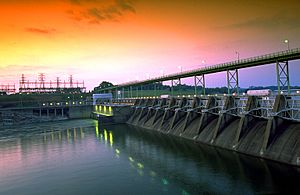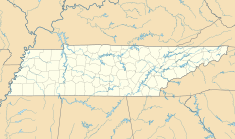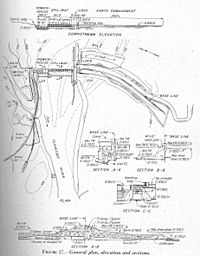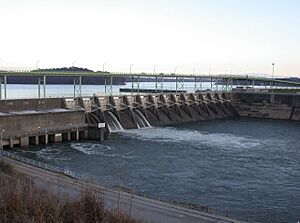Fort Loudoun Dam facts for kids
Quick facts for kids Fort Loudoun Dam |
|
|---|---|

Fort Loudoun Dam
|
|
|
Location of Fort Loudoun Dam in Tennessee
|
|
| Official name | Fort Loudoun Dam |
| Location | Loudon County, Tennessee, United States |
| Coordinates | 35°47′27.27″N 84°14′33.54″W / 35.7909083°N 84.2426500°W |
| Construction began | July 8, 1940 |
| Opening date | August 2, 1943 |
| Operator(s) | Tennessee Valley Authority |
| Dam and spillways | |
| Impounds | Tennessee River |
| Height | 122 ft (37 m) |
| Length | 4,190 ft (1,280 m) |
| Reservoir | |
| Creates | Fort Loudoun Lake |
| Power station | |
| Commission date | 1943-1948 |
| Turbines | 1 x 36 MW, 2 x 34 MW, 1 x 40 MW propeller |
| Installed capacity | 144 MW |
The Fort Loudoun Dam is a large hydroelectric dam on the Tennessee River in Loudon County, Tennessee. The Tennessee Valley Authority (TVA) built this dam in the early 1940s. It was part of a big plan to bring electricity and control floods in the Tennessee Valley. The dam also helped create a long, navigable river channel. This channel stretches for about 652 miles (1,049 km) from Knoxville, Tennessee to Paducah, Kentucky. It is the first of nine TVA dams you'll find on the Tennessee River.
The dam creates Fort Loudoun Lake, which covers about 14,600 acres (5,900 ha). The water just below the dam is part of Watts Bar Lake. The Fort Loudoun Dam can make even more electricity because of the Tellico Reservoir. Water from Tellico Reservoir is sent through a canal into Fort Loudoun Lake. The dam and its related structures were added to the National Register of Historic Places in 2017.
Fort Loudoun Dam gets its name from Fort Loudoun. This was an old British fort from the 1700s, built during the French and Indian War. The fort was about 10 miles (16 km) south of where the dam is now. It was named after John Campbell, the 4th Earl of Loudoun. He was the commander of British forces in North America at that time.
Where is Fort Loudoun Dam?
Fort Loudoun Dam is located about 602 miles (969 km) upstream from where the Tennessee River flows into another river. It's also nearly 50 miles (80 km) downstream from the start of the river. The Tennessee River begins where the Holston and French Broad rivers meet near Knoxville.
The Little Tennessee River naturally joins the main river about 1 mile (1.6 km) downstream. However, the Tellico Reservoir now covers most of the lower Little Tennessee. This reservoir is connected to Fort Loudoun Lake by a canal. This canal flows into Fort Loudoun Lake upstream from the dam. Lenoir City is right next to the dam on its north side. The lake itself spreads across parts of Loudon, Blount, and Knox counties.
The dam was built across three small islands called the "Belle Canton Islands." Building the dam, and later the Tellico Dam, changed the landscape a lot. The northern and eastern parts of these islands are now underwater. The southern and western parts were joined with the mainland and part of Bussell Island. This created one large island. This new island is separated from the mainland by the Tellico canal to the south. The main Tennessee River channel is to the north.
From 1963 until 2017, a road called Lamar Alexander Parkway crossed the J. Carmichael Greer Bridge on top of the dam. This bridge connected the area to major highways like Interstate 75 and Interstate 40 to the north. It also linked to Maryville and the Great Smoky Mountains National Park to the south. A new bridge was finished in 2017. It now carries the Parkway traffic across the river, located southeast of the dam.
Dam Size and Power
Fort Loudoun Dam is 122 feet (37 m) tall. It stretches 4,190 feet (1,280 m) across the Tennessee River. The lake it creates has 379 miles (609 km) of shoreline. It covers 14,600 acres (5,900 ha) of water. The dam can store 111,000 acre-feet (137,000,000 m³) of water to help control floods.
The dam has a special lock for boats. This lock is 60 feet (18 m) wide and 360 feet (110 m) long. It lifts and lowers boats about 70 feet (21 m). This allows boats to travel between Fort Loudoun Lake (upstream) and Watts Bar Lake (downstream). The dam has four hydroelectric generators. Together, these generators can produce 155.6 megawatts of electricity.
To make even more power, water from the Little Tennessee River is sent into Fort Loudoun Lake. This happens through a short canal from the Tellico Reservoir. The canal is about half a mile long. It creates an island with Fort Loudoun Dam at one end and Tellico Dam at the other. This canal also lets large boats, like barges, travel between Tellico Reservoir and Fort Loudoun Lake.
Building the Dam
In the mid-1930s, the TVA created a "unified plan." This plan had long-term goals for building many dams along the Tennessee River. The main goals were to create a 9-foot (2.7 m) deep navigation channel along the entire river. They also wanted to control floods in the Tennessee Valley and bring electricity to the area.
The Fort Loudoun project was first called the "Coulter Shoals project." The U.S. Army Corps of Engineers had identified this site in the early 1930s. It was about 6 miles (9.7 km) upstream from the current dam. After looking at the area, TVA decided to move the project to the Belle Canton Islands.
TVA suggested the project in 1939, and it was approved on April 18, 1940. Construction started on July 8, 1940. Many of the workers had just finished building other TVA projects on the Hiwassee River. TVA originally planned to finish the dam in 1944. However, World War II started, which meant more money and a greater need for speed. The dam was finished quickly, and its gates closed on August 2, 1943. The first generator started making electricity on November 9, 1943. The second one began on January 15, 1944.
Building Fort Loudoun Dam meant buying 16,200 acres (6,600 ha) of land. 317 people, 6 cemeteries, and over 60 miles (97 km) of roads had to be moved. The construction used a huge amount of materials: 582,000 cubic yards (445,000 m³) of concrete and 122,000 cubic yards (93,000 m³) of riprap (loose stones).
Original plans called for four 24-megawatt generators. This was changed to three 32-megawatt generators after the Cherokee Dam was built. The dam's lock, which helps boats pass, was designed by the Army Corps of Engineers. It was finished in June 1943. The lake created by the dam covered part of Louisville, Tennessee. It also required changes to Knoxville's riverfront.
In 1942, TVA got permission to build another dam. This dam, then called the "Fort Loudoun extension," would be across the mouth of the Little Tennessee River. It would send water through a canal into Fort Loudoun Lake. With this new dam planned, TVA was allowed to add a fourth 32,000-kW generator. However, the War Production Board gave the dam's third and fourth generators a "low priority." This stopped funding for the Fort Loudoun extension, and the project was put on hold. In the 1960s, the idea for the Fort Loudoun extension was brought back as the Tellico Dam project.





